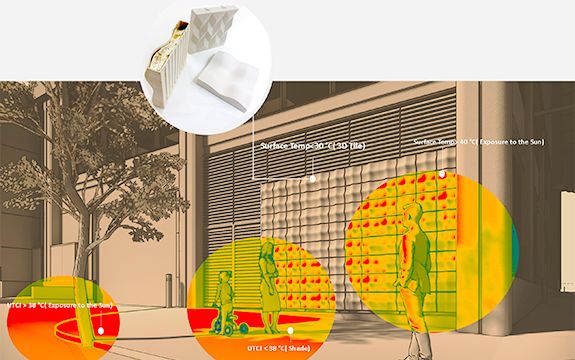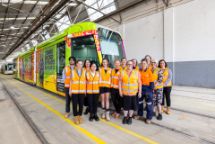Ceramic skins insulate and protect city buildings and inhabitants

Latifi’s hollow ceramic tile filled with mycelium, image by Mehrnoush Latifi.
In summary
- Latifi focuses on the design of ‘active skins’ for buildings
- Insulative and thermodynamic shells for buildings and structures
- Tiled skins create healthy microclimates for people in cities
Dr Mehrnoush Latifi Khorasgani is a Lecturer in Architecture at the Swinburne School of Design, and Theme Leader of the Smart Skins Smart(er) Cities research stream for Future Urban Infrastructure at the Swinburne Smart Cities Research Institute. She exhibited her Fireless Skin, a non-flammable skin for buildings, in a group exhibition with fellow designers and academics during Melbourne Design Week.
Latifi is a practising architect who bridges science and art in her creative practice. She investigates and develops ceramic skin systems that function as insulative and thermodynamic shells for buildings and structures. Her creative practice, research and teaching spans the fields of architecture, virtual and augmented reality, thermal comfort, microclimate design, and digital fabrication.

Illustration by Latifi showing her ceramic skin system on a building surface
When applied to the surfaces of buildings, her interlocking hollow ceramic tile systems provide protection from cold, heat and noise. Her Fireless Skin design is a system of hollow ceramic building tiles that are filled with mycelium to improve the thermal and acoustic properties of walls and structural surfaces. The tiles feature customisable decorative surfacing and glazing options created using digital and traditional production technologies.
Latifi is currently analysing the thermal performance of the ceramic-mycelium material at Swinburne. The Fireless Skin project has multiple collaborators researching ceramic, mycelium and the use of additives such as glass fines.
“The idea of looking at ceramic components as an active skin for buildings, to collect energy through a façade, or to use a biomaterial inside as an insulation layer is the main focus of my research at Swinburne,” Latifi explains.
“My research for Smart Skin Smarter Cities at the Swinburne Smart Cities Institute focuses on the design of ‘active skins’ for buildings. This is about using the skin of buildings as an opportunity to generate energy and to create pleasant microclimates for cities and inhabitants,” she says.

Stacked ceramic tiles at the Fireless Skin exhibition, photography by Mehrnoush Latifi

Assembled ceramic tiles with mycelium fill, at Fireless Skin exhibition, photography by Mehrnoush Latifi
With recent catastrophic failures of flammable cladding systems in Australia and overseas, Latifi says installing ceramic tile components filled with air or biomaterials such as mycelium (also making the components lighter), could be a viable alternative.
“Fully glazed facades are also problematic. They are turning our cities into jungles of iron and glass that can burn surrounding environments on hot days. Facade layering is an opportunity to not only protect people who are living and working inside a building but to also create pleasant microclimates in our cities,” says Latifi.
Read more news on design at Swinburne
-
Media Enquiries
Related articles
-

- Design
Swinburne alum launches zine celebrating Asian Australian art and identity
Swinburne Graphic Design alum Dan Truong founded HOISZN, a zine publication showcasing Asian Australian artists and their work.
Monday 01 July 2024 -

- Design
Swinburne students shine in lighting design collaboration
Swinburne students collaborated with About Space Lighting, resulting in several student-designed lamps being put into production.
Friday 07 June 2024 -

- University
Swinburne University of Technology partners with Grande Experiences and THE LUME Melbourne for cutting-edge Immersive Media education
Swinburne University of Technology is proud to announce its partnership with Grande Experiences and THE LUME Melbourne, enhancing the future of Immersive Media education.
Thursday 13 June 2024 -

- Design
Yarra Trams feature Women in Trades campaign designed by Swinburne students
School of Design and Architecture students in Swinburne’s Bureau collaborated with Tradeswomen Australia Group to design a tram wrap celebrating women in trades.
Thursday 16 May 2024 -

- Design
- Astronomy
- Technology
- University
Swinburne ‘Rock Muncher’ takes part in Australian Rover Challenge
A multidisciplinary student team from Swinburne University of Technology competed in the 2024 Australian Rover Challenge held in Adelaide, South Australia.
Thursday 11 April 2024

